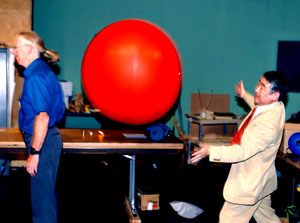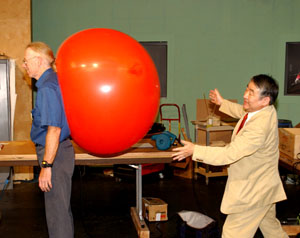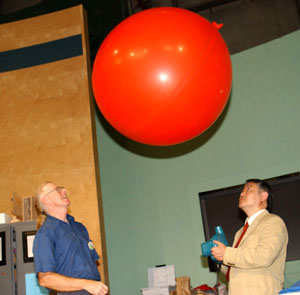
Dr. Takikawa throws a large balloon at me, itcontains a kilogram of air.
Try This! Big Balloon
An exploration demonstrated by Dr. Yoji Takikawa
(image)
Introduction
A big balloon packs a strong punch when it is thrown.
Material
Mega Balloon (available from Klutz Press 3 balloons for $6)
A balloon pump, a leaf blower, a raft inflator pump, or good lungs
A friend.
Try This
Inflate the balloon until it is a meter in diameter (a yard).
Notice how heavy the empty balloon feels and how heavy the inflated balloon feels. The inflated balloon does not feel very heavy.
Have a friend stand with his or her back to you. Throw the balloon at their back.

Notice how the impact of the balloon pushes me over.

What's Going On?
The balloon contains about a four-tenths of a kilogram of air. However the gravitational force on the balloon is just about balanced by its buoyancy since it displaces air.
However the balloon still has sizable mass of 0.4 Kg (about a pound) and when thrown at someone carries a noticeable amount of momentum.
So What?
This exploration helps to illuminate the difference between gravitational mass, which in this case is balanced by the buoyant force from displaced air, and the inertial mass, the mass that gives the balloon inertia. An object like the balloon has inertia, which means that when it is in motion remains in motion at a constant speed until a force acts on it.
Going Further
Try levitating the balloon in an airstream from a leaf blower.

Math Root
The volume of the spherical balloon , V in cubic meters, is V = 4/3 p r^3
where r is the radius of the balloon in meters.
A balloon with a diameter of 1 m has a radius of 1/2 m and a volume of approximately 1/2 m^3
The density of air is 0.8 Kg/m^3 so the mass of the air in the meter diameter balloon is 0.4 Kg.
Activity written by Paul Doherty.
|
Scientific Explorations with Paul Doherty |
|
19 July 2003 |